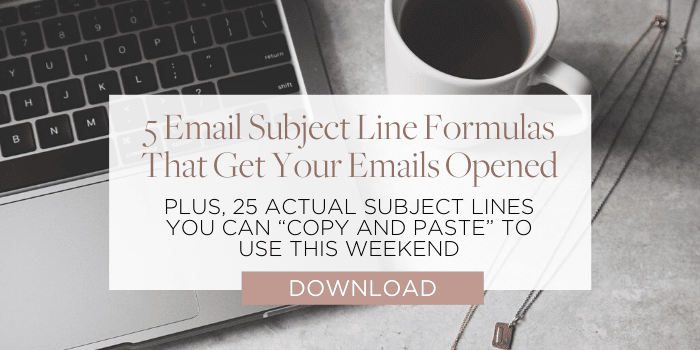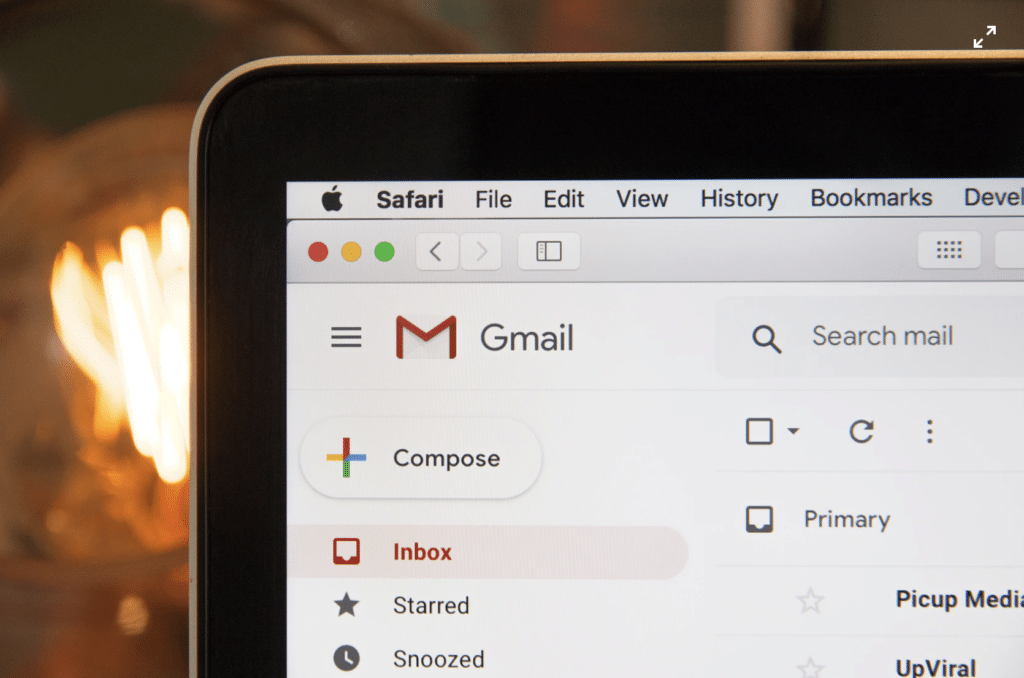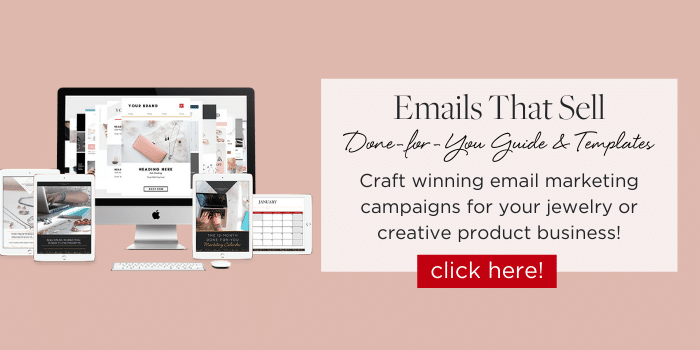7 Tips to Write Email Subject Lines People Want to Open

Everyone knows the old adage about judging a book by its cover. Unfortunately, the same is true for emails. You can write the greatest email to ever grace the internet, only to have it fall flat. Why? The subject line is all wrong.
Email marketing subject lines play a big role in your email’s success. While the body of your email can sell your jewelry, the subject line has the colossal task of getting people in the proverbial door. But, there’s good news—with a few quick tips you can craft an appealing subject line that lands your beautiful jewelry in front of the right people.
First, let’s take a look at why email marketing subject lines matter in the first place, then we’ll get into the good stuff.
Why Email Marketing Subject Lines are Important

There’s a lot of noise online, and the same is true for our inboxes. If you’re lucky, you only receive a dozen or so emails a day in your personal inbox. But, for everyone else it’s likely that daily inbox number is greater than 100 emails per day.
In other words, you’ve got a lot of competition when it comes to standing out in someone’s inbox. But, with the right email marketing subject line your email can shine as bright as a diamond. However, the wrong subject line will likely leave your email unopened, ignored, and eventually deleted.
What Makes a Great Email Marketing Subject Line
A great email marketing subject line is a lot like a great cake—the right ingredients make all the difference. When it comes to email subject lines, there are a few key ingredients to include.
- Psychology: Believe it or not, psychology plays a role in the success of a subject line. Dale Carnegie, author of the famous “How To Win Friends and Influence People,” claimed someone’s name is one of the greatest things that person can hear. Hence the importance of personalizing emails.
- Phrasing: Phrasing is everything, especially when you’re competing with 100 or more emails every day. A great subject line is brief, urgent, and ultimately to the point.
- Campaign fit: Email is great, but it’s also only one part of your marketing strategy. The best email subject lines play into a campaign strategy, whether directly or indirectly.
- Targeting: Who your subject line targets is huge. You wouldn’t offer your friend a chocolate cake when she likes vanilla, right? The best subject lines use language that targets the right people from your list.
Get the above pieces right in your email, and you’re setting yourself up for success. (Don’t worry, we’ll show you how in a bit!)
10 Types of Subject Lines to Try
There’s no single “best” email subject line. What works for your friend or competitor might work for you, but it also might fall flat. And even then, it’s unlikely any single email subject line will succeed with your entire customer base. This is why it’s important you try a variety of subject lines.
To help you start out on the right foot, here are some email subject lines you should try ASAP!
- Personalized subject lines: Personalizing subject lines with the recipient’s first name is a great way to catch their attention, make the email personal (duh), and drive open rates. You don’t need to personalize every email, but give it a shot and see how similar subject lines perform when using and not using personalization.
- Offer-driven subject lines: While some subject lines succeed because of their chumminess, others succeed because they’re to the point and focused on the offer. If you’re running a sale or promotion, try leaning into it with a subject line that calls out the discount you’re offering.
- Emojis: Emojis are a bit of a gamble, as some audiences might hate them. But, if you have a slightly younger audience, consider trying out an emoji in your subject line. It’s a fun, simple way to add some color and set your subject line apart from the droves of emails in the recipient’s inbox. 😉
- Play into FOMO: Fomo, or the fear of missing out, is all about reminding people of the fact that they’ll be left out if they don’t do something. FOMO subject lines work especially well when you’re reminding readers a sale’s about to end, but can even work when you release a new piece. (For example, “Make a statement with my latest copper bracelet before it’s gone”)
- Be unique (or straight up weird): Have you ever stumbled across an email you just HAD to open? Play into the curious nature of people and write a subject line that makes readers think, “I must click.” Much like this link that leads to a blog that might change your life.
- Address customer pain points: Jewelry is a beautiful way to make a statement, but sometimes it’s useful for helping us deal with pain points. (Like totally nailing an outfit for a summer wedding.) Craft a subject line that taps into customer pain points while describing your latest piece. Again, like calling out your new piece’s ability to tie an outfit together.
- Short and sweet: Simplicity is sometimes the best route to take. Your customers are busy and so are you. Respect their time with a short and sweet email subject line that gets right to the point. (For example, “Let’s complete that order in your cart”)
- Start with a number: Take a moment to look at your inbox. I’m willing to bet most of the subject lines you’re seeing start with letters. Starting a subject line with a number, like the number of a discount for example, helps your subject line stand out from all those letter-heavy subject lines.
- The personal approach: Not to be confused with personalization, sometimes emails simply need to be personal. Write a subject line that directly addresses the reader, maybe even with a question. Tap into their humanity and remind them you’re a person, too. (For example, “Feeling blue?” could lead into an email promoting your radiant new piece, sure to cheer anyone up.)
- Offer readers something: Sure, you’re trying to market your brand and jewelry. But, you should still offer your readers something of value once in a while. Use the subject line to tell readers about a new video or informational blog that’s linked or embedded in the email. Remind your readers you care about them!
It’s important to note none of the above approaches work 100% of the time. You may find an email crushes it one month and flops the next. Don’t fret! People get burnt out on the same approach, so be sure to mix things up and try new subject line types.
5 Things to do After Launching an Email

Crafting an email subject line is only half the battle. There are a few key steps you need to take in order to ensure you’re getting the most out of your emails. Going back to the cake analogy, you wouldn’t give your friend a cake you baked and not ask for feedback, right?
To get the most out of your email efforts, here are a few practices to implement.
- A/B test: It’s easy to think an email did well simply because an open rate “looks good.” But, “good” is relative. Anytime you try a new subject line, grab a small sample of your list and send two versions of the email to each half of that segment. Then, see which subject line performed better and run with it.
- Optimize emails: After A/B testing, it’s time to optimize emails. Pay close attention to how every email performs, looking at the open rates, click-through rates (people that clicked the link in the email), and so on. Then, find commonalities between your top performing emails and apply what you’ve learned to future campaigns.
- Segment your lists: It’s always tempting to send your emails to everyone on your list. While this sometimes works, like in the case of a newsletter or major announcement, more often than not you want to segment your list. Analyze your list and send certain subject lines or email types to the demographics that make the most sense of that particular email. (For example, your “Baby come back” email with an offer should go to those who haven’t opened an email in ages, not everyone on your list.)
- Monitor unsubscribes: Take note of how many people unsubscribe from your email list after a particular email. If you notice a spike after a particular email was sent, especially if that email wasn’t opened by most of the list, you can be pretty sure the subject line did NOT resonate with your audience.
- Keep tabs on spam reports: Unless you’re the canned meat found on the shelf, you don’t want to be flagged as spam. Along with your unsubscribe rate, keep tabs on your spam report rate. If you have a certain email that sees a spike in your spam reports, there’s likely a problem with the language that caused people to flag the email.
The above probably sounds like a lot of work. While each of these steps takes time the first few times you do it, it becomes natural over time. And better yet, these practices help your emails and your brand thrive!
Simplify Your Email Marketing With Tried and True Emails

Email marketing is a lot of work. But, it’s an effort that’s well worth the trouble. You have beautiful, unique products your audience needs to see, and carefully crafted subject lines can help that become a reality.
But, rather than put all this work on yourself, why not go with email subject lines and templates that are tried and true? With our Emails that Sell package, you get:
- More than 600 professionally-crafted subject lines
- Canva email templates that are ready to rock from the get go
- An urgency-focused promo plan that will urge your customers to click
- A 12-month marketing calendar that takes the guesswork out of planning
Which would you rather do: work on crafting the perfect email, or hand-craft your next masterpiece that flies off the shelf? With our Emails that Sell kit you can focus on your art and do what you love the most. And all for the low price of $47.
Simplify your email marketing with professionally-crafted email marketing materials today!
